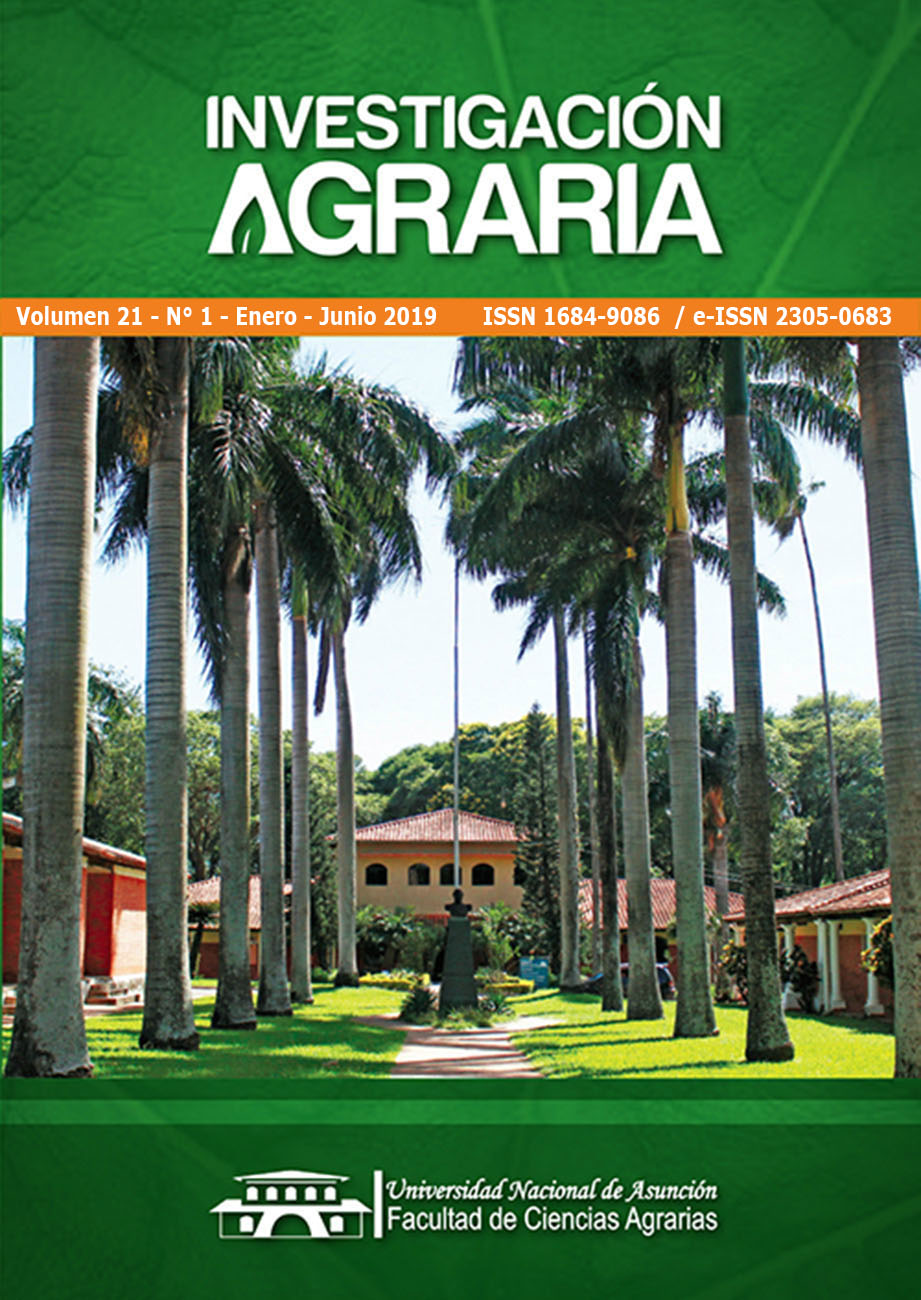Flowering, fructification and seed production in plants of Polystachya concreta (Jacq.) Garay y H.R. Sweet (Orquidaceae)
DOI:
https://doi.org/10.18004/investig.agrar.2019.junio.65-72%20%20Keywords:
Polystachya concreta, fruits, physical dimension of seeds, viabilityAbstract
Polystachyaconcreta (Orchidaceae) is an epiphytic herbaceous plant, found in Salta, Jujuy, Corrientes and Misiones (Argentina).The objective of the work was to evaluate in P. concreta a) the flowering andfruiting,b) seeds production (number and mass) and c) its viability.Two groups of plants (I and II) were taken from in vitro culture with 21 and 26 months from germination respectively, acclimated and cultivated in greenhouse in plastic containers with organic substrate and others mounted on stick with Sphagnum moss. The two groups of plants were evaluated separately in terms of flowering and fruiting, but the measurements in seeds (morphological characteristics and physical determinations with digital images) and their viability (Technique of tetrazolium) were made with random samples of all the fruits harvested as a whole. The percentage of flowering was of 84 and 60% (January-February) and that of fruiting of 75 and 44% (May-June), for group I and II, respectively. The plants, coming from seeds, reached first flowering in 42 months. The average mass of seeds per fruit was 0.19 ± 0.11 mg and the average number of seeds per mg was estimated at 1770 ± 628. Fruit production was high and with a high percentage of viable seeds (93%).Downloads
Metrics
References
Augustine, J., Yogendra, K. & Sharma, J. (2001). Orchids of India II: Biodiversity and status of Bulbophyllum Thou. Tri Nagar, New Delhi: Daya publishing house.
Ayuso, J.B. (2017). Los frutos y las semillas de las orquídeas. Capítulo 6 (en línea). En Orquídeas silvestres del sistema ibérico. p. 524-598. Recuperado de: https://www.researchgate.net/publication/320508516_Los_frutos_y_las_semillas_de_las_orquideas?_sg=_WJ7LHx-
Arditti, J. (1979). Aspects of the physiology of orchids. Adv. Bot. Res., 7, 241-665.
Arditti, J. & Ghani, A.K. (2000). Numerical and physical properties of orchid seeds and their biological implications. New Phytol., 145, 367- 421.
Barthlott, W., Grobe-Veldmann, B. & Korotkova, N. (2014). Orchid seed diversity: s scanning electron microscopy survey. Berlin-Dahlem: Botanic Garden and Botanic Museum, 245 p.
Billard, C., Barsanti, V. y Lallana, V.H. (2014). Cultivo «in vitro» y aclimatación de plantas de Polystachya concreta (Orchidaceae). Revista FABICIB, 18, 95-106.
Chemisquy, M.A., Prevosti, F.J. & Morrone, O. (2009). Seed morphology in the tribe Chloraeae (Orchidaceae): combining traditional and geometric morphometrics. Bot J Linn Soc., 160, 171-183.
De La Cruz, V., Schimpf, K. y Lallana, V.H. (2012). Protocolo N° 41: Medición digital de la longitud y ancho de semillas de orquídeas. 5 p. Disponible en: http://www.orquier.fca.uner.edu.ar/protocolos
Fay, M. y Clemente, M. (1997). Aplicación de las técnicas de cultivo de tejidos en propagación y conservación de especies amenazadas. Monograf. Jard. Bot., 5, 43-50.
Ferreira, T. & Rasband, W. (2011). ImagenJ userguide. IJ 1.45 m. 152p. Recuperado de: http: //imagenJ.nih.gov/ij/docs/userguide.pdt.
Flachsland, E., Terada, G., Rey, H. y Mroginski, L. (1996). Medios de cultivo para la germinación in vitro de 41 especies de orquídeas. FACENA, 12, 93-100.
García, L.F y Lallana, V.H. (2014). Protocolo para el análisis de viabilidad de semillas de orquídeas con la prueba topográfica por tetrazolio. Revista Análisis de Semillas, 7(28), 75-78.
Johnson, E. (2001). Las orquídeas del Parque Nacional Iguazú. Buenos Aires, Argentina: L.O.L.A., 296 p.
Lallana, V.H. (2015). Nuevo método para el conteo de semillas de orquídeas. XII Jornadas de Ciencias Naturales del Litoral. 2-3 noviembre de 2015. Paraná, pp 119.
Lallana, V.H. y García, L.F. (2016). Viabilidad de semillas de orquídeas almacenadas en frio. En Néstor Di Leo, H.L. y Seghesso, A. Libro de resúmenes de la I Reunión Transdisciplinaria en Ciencias Agropecuarias. XVII Jornada de Divulgación Técnico-Científicas de la Facultad de Ciencias Veterinarias, UNR. II Jornadas de Ciencia y Tecnología, 2016. Rosario: Foja Cero, pp. 143-144.
Lallana, V.H. y Wagner, J.B. (2017). Aclimatacion y sobreviencia de plantas de orquídeas provenients de cultivo “in vitro”. In: Seghesso, A., Labria, H., Di Leo, N (comp.) Libro de resúmenes de la II Reunión Transdisciplinaria en Ciencias Agropecuarias. XVIII Jornada de Divulgación Técnico-Científicas de la Facultad de Cs. Veterinarias, UNR. III Jornadas de Ciencia y Tecnología. 2017. Zavalla, Rosario: Fundación Ciencias Agrarias, pp. 119-120
Lallana, V.H. y Di Persia, J.F. (2018). Caracterización morfométrica de semillas de cuatro especies de orquídeas terrestres nativas de Argentina. Ciencia, Docencia y Tecnología, 29(57), 272-284. https://doi.org/10.33255/2957/423
Murshigue, T. & Skoog, F. (1962). A revised medium for rapid growth and bioassays with tobacco tissue culture. Physiologia Plantarum, 15, 473-497.
PID-UNER 2144. (2009). Conservación de orquídeas nativas de Entre Ríos utilizando técnicas de cultivo de tejidos «in vitro». Proyecto de Investigación y Desarrollo-UNER. Aprobado por Res. C.S. n° 109/10 (19/08/10). Director: Dr. Víctor H. Lallana. 31 p.
Rodríguez, L., González, R., Alvarado, K. y Telles, E. (2007). Germinación asimbiótica in vitro de semillas de orquídeas silvestres. Biotecnología Vegetal, 7(3), 139-142.
Thompson, P.A. (1980). Orchids from seed: Royal Botanical Gardens. London, 29 p.
Vásquez, R. y Ibish, P.L. (ed). (2004). Orquídeas de Bolivia: diversidad y estado de conservación. Bolivia: FAN, 649 p.
Verma, J., Sharma, K., Thakur, K., Kaur, J. & Prakash, S. (2014). Study on seed morphometry of some threatened Western Himalayan orchids. Turk J Bot, 38, 234-251.
Downloads
Published
How to Cite
Issue
Section
License

This work is licensed under a Creative Commons Attribution 4.0 International License.
All content in this journal is under Creative Commons Attribution License.









 All content in this journal is under
All content in this journal is under 